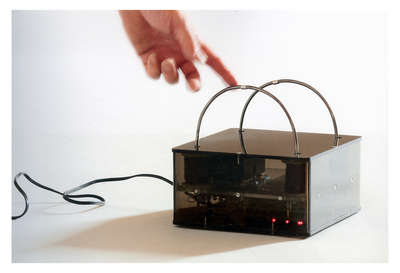Abacus may be seen as the work with the most obvious formal similarity to Minimal Art.
It is a cube made of sheet acrylic with two small steel arches across it, comparable to minimalist plastic works, although its coffee table size makes it seem more like a minature model of Minimal Art, which was realised on a large scale in most cases.
However, the work display minimalist aesthetics externally, it can be clearly distinguished from sculptures of Minimal Art, which becomes particularly obvious on the basis of Abacus.
Here the element of movement destroys the minimalist aesthetics in a manifest way. It is possible to discern this characteristic as the recipient, for while one is viewing the acrylic glass cube with the two stainless steel arches and regardig it as ”cool”, one is suddenly suprised by two small aluminium rings that jump at irregular intervals from one end of the steel bars to the other, creating a short metallic sound as they do so. In an exhibition, Abacus lays claim to the space that it lacks in volume by means of sound. The repeated clicking destroys the material ”coolness” and not only indicates that this work functions mechanically, but also that it concerns a process rather than existing as a plastic sculpture. It is based on a system and a programme that take place in the background. As an exception on the series of objects that work with light bulbs, in Abacus the visualisation is based on four electromagnetic fields, which are activated at irregular intervals by means of White’s electronic programming and thus shoot the rings across the steel arches. While the external form fits perfectly into contemporary minimalist aesthetics, the two jumping rings constitute a meaningless action, an absurd level of this sculpture. In addition, it is impossible to follow the system of the action, since it appears to take place irregularly due to the incoherence of the four electromegnetic fields and two aluminium rings. The process in Abacus appears to be coincidental and so contradicts the fundamental minimalist demands of symmetry, logic and transparency.
(Herzogenrath & Lähnemann 2009:20f.)
Size: 10,5 × 20,5 × 20,5 cm


